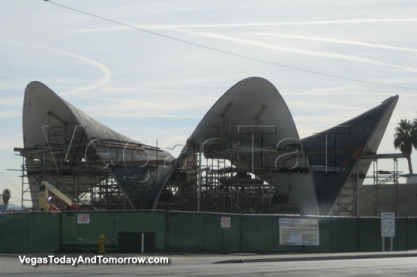
Growing up in Las Vegas, it was always there. As kids we didn't give it much thought. By 1964, the testing was all done underground. Pres. Kennedy had signed the Limited Test Ban Treaty before his death that banned above-ground atmospheric testing of nuclear weapons. The Test Site would issue a warning that it was going to be doing underground nuclear testing and we might feel the jolt. It was alot like experiencing a medium sized earthquake. The ground would shake and after a few minutes, it would pass.
When I moved to Los Angeles until the Northridge Earthquake of 1994, earthquakes didn't get my attention much because they were so similar to the Underground Testing I had grown up with.
The United States Government decided in the late 1940s that it needed a new Test Site. The Bikini Atoll where they had been testing was too far away and the wind and weather changes made planning difficult. The Atomic Energy Commission decided to bring the above-ground testing of Atomic Bombs stateside. It was the Cold War and discussions about the hazards involved with the Testing were whisked aside.
Nevada, specifically Southern Nevada, fit the bill. Sparsely populated with Nellis Air Force base nearby in Northtown, Frenchman's Flat, located about 60 miles north of Las Vegas was chosen.
Scientists from around the country were recruited to come to Las Vegas. Atomic Scientist Al O'Donnell remembered "The Atomic Age is here and you'd be on the ground floor of testing of atomic weapons." The engineering and scientific companies like E.G.&G came to Las Vegas and brought their staffs with them. "Millions of dollars came into Las Vegas because these companies wanted a piece of the action. " Al O'Donnell told me in a 2005 interview.
Camp Mecury was set up and soldiers were deployed to the remote base to supply support for the scientists. The soldiers would be on the front line, digging trenches and then watching the bomb blast from those trenches before being sent out to explore the bomb site after the explosion. The soldiers were assured that every precaution was taken and that there was no harm in being that close to ground zero.
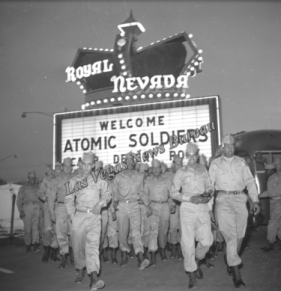
Atomic Soldiers at the Royal Nevada
(courtesy of the Las Vegas News Bureau)
In Las Vegas, residents were assured that the Atomic Testing was not harmful. The government encouraged school children to get up in the early morning hours and watch the bomb go off from their front yards. Young adults like Bud Kennedy and John Ullom would drive out the old Tonopah Highway, pull over on the side of the road and watch the explosions from there.
Las Vegas News Bureau photographers such as the late Don English, would go out to News Nob, located 7 miles from the blast site, where the press from all over the world would be lined up with their cameras and their movie cameras to photograph the explosions. One time Don overslept. He knew he wouldn't have time to get out to News Nob before the detonation. He hurried down to Fremont Street and climbed up on the roof of the Golden Nugget and waited. There were workmen there installing a glass skylight and they asked him what he was doing. He told them they would know shortly. The bomb went off. As the mushroom cloud rose in the sky, the ground began to shake and the panes of glass broke. Don didn't lose his concentration and snapped a photo of the mushroom cloud rising with downtown Las Vegas in the foreground. The photo went out on the wire and became Life Magazine's photo of the week.
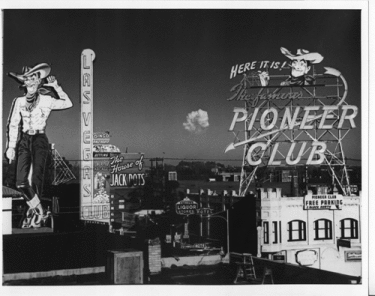
Don English's famous photo of a nuclear cloud over an American City.
Donna Andress remembers that "we weren't fearful of it. We were assured over and over again that there was never going to be a problem."
Don English remembered that "we believed everything the A.E.C. (Atomic Energy Commission) said and we figured we were quite safe. They did give us precautions, you know, not to look at it during the blast. They gave us dark glasses and we would turn away at that close distant. As soon as you saw the flash, then you could turn around and start shooting."
Emmett Sullivan, who had been born in Las Vegas in the mid-1920s, remembers "It was one of the most beautiful things I ever saw in my life. As it died down you saw all the colors of the rainbow."
Most remember being jostled out of bed in the wee hours of the morning while it was still dark out. "It was always early, like 4 or 5:00 in the morning. You could be in your bed and it was like somebody had turned on a light on right in your face. And then you'd hear the noise and run outside so you could see the mushroom cloud forming." Ken Gragson told me in a 2003 interview.
If the wind was blowing towards Las Vegas, the test would be called off and rescheduled. It was one of the concessions the A.E.C. had made when it came to Southern Nevada.
With the signing of the Limited Test Ban Treaty, the testing went underground. While we didn't get jostled out of bed, some of the tests were so explosive that they did get our attention. One bomb was so big that it knocked out the floor to ceiling display windows at the Woolco in our Charleston Heights neighborhood.
There were rumors of the bombs being vented afterwards but again the A.E.C. and local officials assured us everything was safe.
Looking back now, it's easy to say that we were naive but back then there was more trust in the government, especially in the 1950s.
By the 1970s, there were stories coming out of Southern Utah from the small towns downwind of Las Vegas. People were dying of cancer at a rate higher than normal. John Fuller wrote a book "The Day We Bombed Utah" which recounted how the story of how the above ground testing had devasted a family of sheep farmers in St. George and the effects of not only cancer but thyroid disease on the small farming communities of Southern Utah. Fuller also raised the question that perhaps it was filming on location in Moab and other areas for the movie, The Conqueror (during a particulaly busy summer in 1954 when the Test Site was in full-swing) that led to the deaths of the stars of the movie John Wayne and Susan Hayward along with many of the cast and crew.
My family used to drive to Southern Utah to get fresh fruit and vegetables. A day trip to St. George or Cedar City was fun. It gave us a break from the desert climate and landscape.
I think of these things each morning when I take my thyroid medication. And I wonder how many more who grew up in Las Vegas during those times are taking their thyroid meds as well.
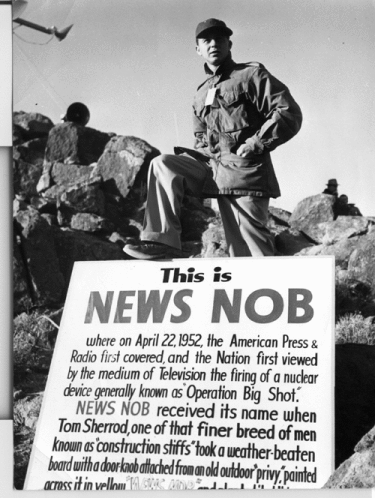
Don English at News Nob
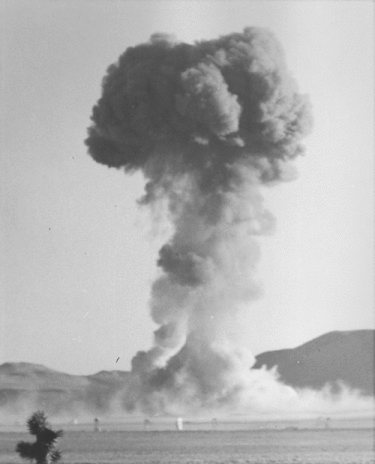
Imagine having to get out of your trench and head towards that
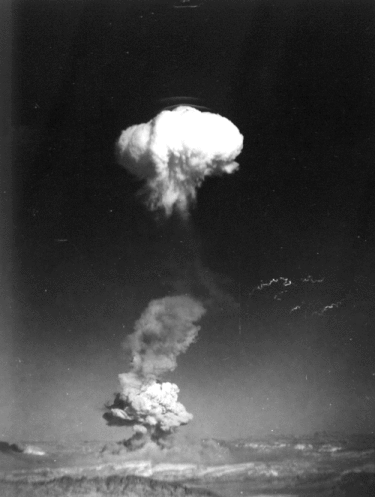
Special thanks to the Family of Don English, Bo Boisvert and the Las Vegas News Bureau for letting use this images.
For more information on the Test Site we encourage everyone to visit the Atomic Testing Museum on E. Flamingo.
For more personal stories of Las Vegas at that time and growing up with the bomb, we encourage you to buy the DVD: The Story of Classic Las Vegas: An Overview


